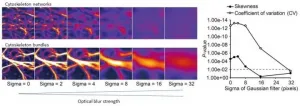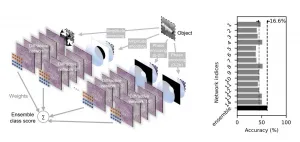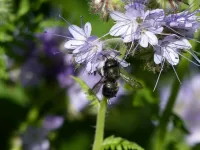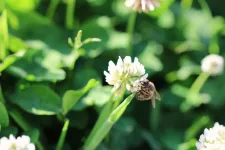A highly sensitive technique for measuring the state of a cytoskeleton
2021-01-14
(Press-News.org) A research group from Kumamoto University, Japan has developed a highly sensitive technique to quantitatively evaluate the extent of cytoskeleton bundling from microscopic images. Until now, analysis of cytoskeleton organization was generally made by manually checking microscopic images. The new method uses microscopic image analysis techniques to automatically measure cytoskeleton organization. The researchers expect it to dramatically improve our understanding of various cellular phenomena related to cytoskeleton bundling.
The cytoskeleton is a fibrous structure inside the cell made of proteins. It forms higher-order structures called networks and bundles which maintain or change the shape of the cell depending on its state. An accurate understanding of the structures woven by the cytoskeleton makes it possible to estimate the state of a cell. In the past, analysis of the higher-order cytoskeleton structures was generally done by visual observation of the stained cytoskeleton under a microscope by an expert. However, these conventional methods are based on the subjective judgment of the researcher, and thus lack objectivity. In addition, as the number of specimens to be analyzed increases, the personnel costs for experts also grows.
To counter these issues, Associate Professor Takumi Higaki of Kumamoto University has been developing a quantitative method to automatically evaluate the characteristics of complex cytoskeleton structures using microscope image analysis technology. About 10 years ago, he reported that the degree of cytoskeleton bundling could be evaluated by a numerical index he called the "skewness of intensity distribution" from fluorescently stained microscopic images of the cytoskeleton. This technique is now widely used but it has a problem; bundle conditions cannot be accurately evaluated in excessive bundling or when the microscopic image contains a lot of optical blur.
Therefore, Dr. Higaki and a new collaborative research group developed a new quantitative evaluation technique for cytoskeletal bundles that is both more sensitive and versatile than any of the methods described above. Through graphical computer simulations of cytoskeletal bundling, they found that the coefficient of variation of intensities in cytoskeleton pixels nicely reflected the bundle state. Using cytoskeleton microscopic images, they performed a comparative analysis between existing methods and the new method, and found that the proposed method was more sensitive at detecting bundle states than the other methods. They also found that it could be applied to a multitude of biological samples and microscopes. Furthermore, they studied the effect of the proposed method on optical blur--a major cause of image degradation in microscope images--and found that it was sufficient for quantitative evaluation of the bundle state even in unclear images.
"This technology will enable the quantitative evaluation of the state of cytoskeletal bundles from a more diverse set of microscopic images. We expect that it will dramatically advance our understanding of cells by furthering our understanding of higher-order structures of the cytoskeleton," said Dr. Higaki. "Since cytoskeletal bundling can now be accurately measured, even from unclear images acquired with inexpensive microscopic equipment, new insights may be obtained by reanalyzing the vast amount of microscopic image data that had not been fully utilized in the past."
INFORMATION:
This research was posted online in Scientific Reports on 21 December 2020.
Source:
Higaki, T., Akita, K., & Katoh, K. (2020). Coefficient of variation as an image-intensity metric for cytoskeleton bundling. Scientific Reports, 10(1). doi:10.1038/s41598-020-79136-x
[Attachments] See images for this press release:

ELSE PRESS RELEASES FROM THIS DATE:
2021-01-14
Data from the DESI (Dark Energy Spectroscopic Instrument) Legacy Imaging Surveys have revealed over 1200 new gravitational lenses, approximately doubling the number of known lenses. Discovered using machine learning trained on real data, these warped and stretched images of distant galaxies provide astronomers with a flood of new targets with which to measure fundamental properties of the Universe such as the Hubble constant, which describes the expanding Universe.
Astronomers hunting for gravitational lenses utilized machine learning to inspect the vast dataset known as the DESI Legacy Imaging Surveys, uncovering 1210 new lenses. The data were collected at Cerro Tololo Inter-American Observatory (CTIO) and Kitt Peak National Observatory (KPNO), ...
2021-01-14
URBANA, Ill. ¬- Illinois residents value efforts to reduce watershed pollution, and they are willing to pay for environmental improvements, according to a new study from agricultural economists at the University of Illinois.
Nutrient runoff from agricultural production is a major cause of pollution in the Mississippi River Basin and contributes to hypoxia - limited oxygen to support sea life in the Gulf of Mexico. The U.S. Environmental Protection Agency (EPA) set up action plans to reduce pollution in 12 midwestern states and reduce transmissions of nitrate-nitrogen and phosphorus by 45% in 2040.
Illinois agencies have established the Illinois Nutrient Loss Reduction Strategy (INLRS) to ...
2021-01-14
Recently there has been a reemergence of interest in optical computing platforms for artificial intelligence-related applications. Optics/photonics is ideally suited for realizing neural network models because of the high speed, large bandwidth and high interconnectivity of optical information processing. Introduced by UCLA researchers, Diffractive Deep Neural Networks (D2NNs) constitute such an optical computing framework, comprising successive transmissive and/or reflective diffractive surfaces that can process input information through light-matter interaction. These surfaces are designed using standard deep learning techniques ...
2021-01-14
CORVALLIS, Ore. - Researchers at Oregon State University have found that the blue orchard bee, an important native pollinator, produces female offspring at higher rates in the aftermath of wildfire in forests.
The more severe the fire had been, the greater percentage of females - more than 10% greater in the most badly burned areas relative to areas that burned the least severely.
"This is one of the first studies that has looked at how forest fire severity influences bee demography," said Jim Rivers, an animal ecologist with the OSU College of Forestry. "Sex ratio varied under different fire conditions but the number of young produced did not, which indicates bees ...
2021-01-14
A first-of-its-kind, international study of 107,000 children finds that higher temperatures are an equal or even greater contributor to child malnutrition and low quality diets than the traditional culprits of poverty, inadequate sanitation, and poor education.
The 19-nation study is the largest investigation of the relationship between our changing climate and children's diet diversity to date. It is believed to be the first study across multiple nations and continents of how both higher temperatures and rainfall--two key results of climate change--have impacted children's diet diversity.
"Certainly, future climate changes have been predicted to affect malnutrition, but it surprised ...
2021-01-14
DALLAS, Jan. 14, 2021 -- The longer the time between when heart attack symptoms start and a patient has an artery-clearing percutaneous coronary intervention (PCI), the more damage to the heart muscle, according to new research published today in Circulation: Cardiovascular Interventions, an American Heart Association journal.
A heart attack happens about every 40 seconds in the U.S., and the most common heart attack is caused by a complete blockage in a coronary artery, called ST-elevation myocardial infarction (STEMI). STEMI patients are most often treated with PCI, also known as angioplasty with stent, in which a catheter with a deflated balloon is inserted into the narrowed heart artery. Subsequently, the balloon is inflated, which clears the obstruction and restores ...
2021-01-14
DALLAS, Jan. 14, 2021 -- Adults who smoke or who are genetically predisposed to smoking behaviors are more likely to experience a serious type of stroke called subarachnoid hemorrhage (SAH), according to new research published today in Stroke, a journal of the American Stroke Association, a division of the American Heart Association. The results of this study provide important evidence that there is a causal link between smoking and the risk of SAH.
SAH is a type of stroke that occurs when a blood vessel on the surface of the brain ruptures and bleeds into the space between the brain and the skull. It mainly affects middle-aged adults and has high rates of complications ...
2021-01-14
MEDFORD/SOMERVILLE (January 14, 2021) - A team of researchers led by engineers at Tufts University's School of Engineering and Stanford University's Program on Water, Health and Development have developed a novel and inexpensive chlorine dispensing device that can improve the safety of drinking water in regions of the world that lack financial resources and adequate infrastructure. With no moving parts, no need for electricity, and little need for maintenance, the device releases measured quantities of chlorine into the water just before it exits the tap. It provides a quick and ...
2021-01-14
There is a growing consensus among scientists as well as national and local governments representing hundreds of millions of people, that humanity faces a climate crisis that demands a crisis response. New research from the University of California San Diego explores one possible mode of response: a massively funded program to deploy direct air capture (DAC) systems that remove CO2 directly from the ambient air and sequester it safely underground.
The findings reveal such a program could reverse the rise in global temperature well before 2100, but only with immediate and sustained investments from governments and firms to scale up the new technology.
Despite the enormous undertaking explored in the study, the research ...
2021-01-14
Honeybee historians might seem like a flight of fancy but these tiny pollinators have been helping researchers from the National Botanic Garden of Wales track how the UK's fields, hedgerows, wild spaces and gardens have changed since the 1950s.Using cutting-edge DNA barcoding techniques, scientists at the Botanic Garden identified which plants modern-day honeybees visited most often by looking at the pollen grains trapped within honey.
They compared this to a 1952 survey of honey plants where a microscope had been used to painstakingly identify pollen grains in honey sent from hives across the country. The differences were clear. White clover had been the most important plant for honeybees but, with fewer pastures today and increased use of herbicides and inorganic ...
LAST 30 PRESS RELEASES:
[Press-News.org] A highly sensitive technique for measuring the state of a cytoskeleton







